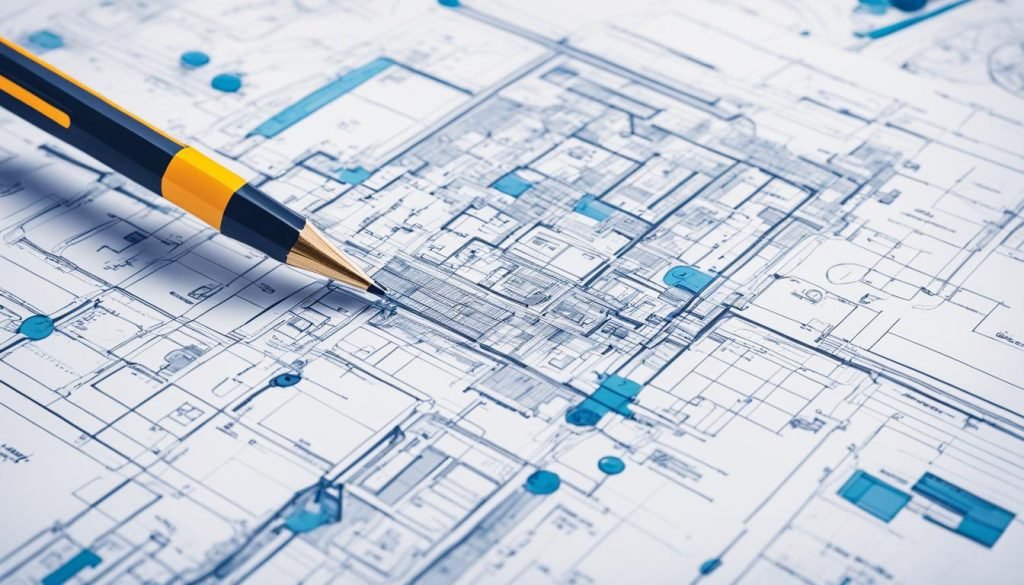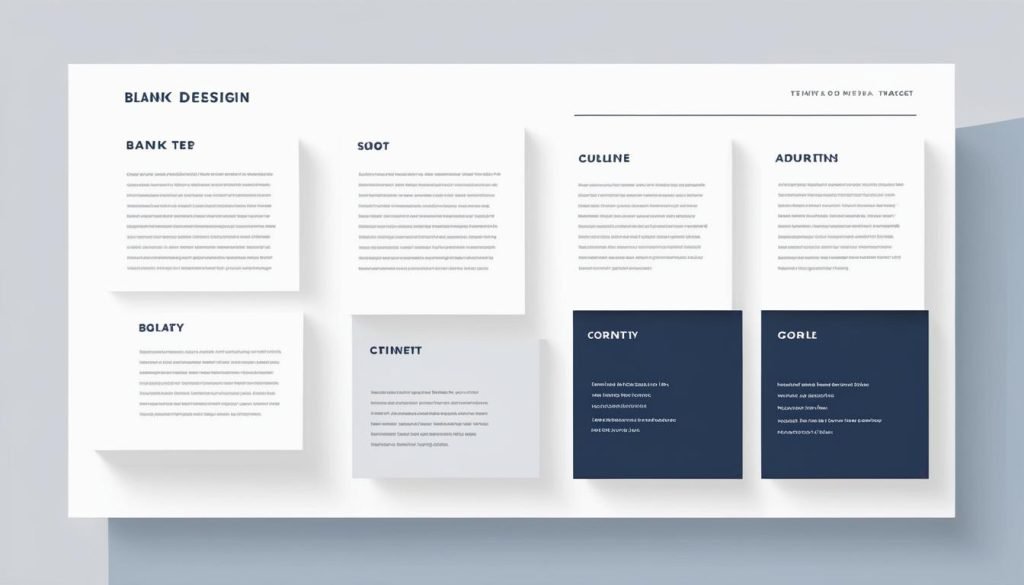A web design brief is a crucial document for starting a web design project on the right foot. It helps identify obstacles, agree upon objectives, deliverables, and expected outcomes, and provides a way to avoid scope creep. The brief outlines the web design process, requirements, and timelines, providing both parties with a clear understanding of what’s expected. It is usually created by the business or web professionals and serves as a project management tool.
Some important points to include in a web design brief are a company profile, core stakeholders, future growth plans, scope of the project, tone or voice of the content, branding details, goals of the website, previous/current website information, target audience, competitors, technical requirements, timeline, cost, and deliverables.
Key Takeaways:
- A web design brief is a crucial document for starting a web design project on the right foot.
- It helps identify obstacles, agree upon objectives, deliverables, and expected outcomes.
- The brief outlines the web design process, requirements, and timelines.
- Include important points such as company profile, core stakeholders, and goals of the website.
- Ensure to cover technical requirements, timeline, cost, and deliverables.
What Is a Web Design Brief?
A web design brief is a comprehensive document that outlines the steps, prerequisites, and schedules involved in a web design project. It serves as a reference point for both you and your chosen web design agency, ensuring clear communication and a mutual understanding of the project’s workflow and objectives. A well-written web design brief allows you to accurately estimate costs and timeframes and facilitates an efficient workflow, collaboration, and revision process. Ultimately, it leads to time and cost savings and ensures the delivery of a high-quality website.
The Importance of a Web Design Brief
A web design brief provides a solid framework for your project, ensuring that all parties involved are on the same page and working towards the same goals.
- Establishes Clarity: By defining the project requirements, objectives, and expectations, a web design brief brings clarity to the project’s scope and helps avoid misunderstandings.
- Efficient Workflow: With a clear roadmap outlined in the brief, the design and development process can proceed smoothly, saving time and reducing delays.
- Enhanced Collaboration: The web design brief serves as a collaborative tool, facilitating effective communication between you and the design agency, resulting in a website that meets your vision and requirements.
- Cost and Time Savings: A well-written brief allows the web design agency to accurately estimate costs and timeframes, preventing unexpected expenses and project delays.
- High-Quality Output: By providing detailed guidelines and expectations, a web design brief ensures that the final website meets your standards and aligns with your brand.
A web design brief acts as a crucial foundation for a successful web design project. It sets the stage for a seamless collaboration between you and your web design agency, ensuring that your vision is accurately translated into an exceptional website.
Why Is a Web Design Brief Important?
A web design brief plays a crucial role in the success of a web design project. By clearly outlining the project requirements, deliverables, and expectations, it brings clarity and direction to the entire process. But what makes a web design brief so important? Let’s explore the key benefits it brings:
- Efficient Workflow: A well-written web design brief acts as a roadmap, guiding the project in the right direction. It helps both the client and the web design agency stay focused on the goals and objectives, eliminating confusion and unnecessary back-and-forth. This leads to a smoother workflow and efficient use of resources.
- Enhanced Collaboration: With a detailed web design brief, the client and the web design agency are on the same page from the start. It allows for effective collaboration by providing a clear framework for communication and understanding. By aligning expectations and sharing a mutual understanding of the project, the collaboration becomes more productive.
- Streamlined Revisions: Incorporating revisions and changes can be a time-consuming and costly process during a web design project. However, a web design brief helps minimize the need for extensive revisions. By defining the project requirements and objectives early on, the brief serves as a reference point that guides the design process, reducing the likelihood of major changes later.
- Time and Cost Savings: The clarity provided by a web design brief helps save both time and cost. It enables the client to estimate accurate costs and timeframes, preventing any surprises along the way. By avoiding unnecessary iterations and scope creep, time and resources can be utilized more efficiently, resulting in cost savings.
- High-Quality Output: The web design brief acts as a blueprint for the project, ensuring that the final output meets the desired quality standards. By setting clear expectations and objectives, it helps the web design agency deliver a website that aligns with the client’s vision and requirements.
In summary, a web design brief is a powerful tool that brings clarity, efficiency, collaboration, cost savings, and high-quality output to a web design project. It acts as a roadmap, ensuring that the project stays on track and within the agreed-upon constraints. By investing time in creating a comprehensive web design brief, you set the stage for a successful and satisfying web design experience.

Next, let’s take a closer look at who should take the responsibility of writing a web design brief and the key stakeholders involved in the process.
Who Should Write a Web Design Brief?
A web design brief is an essential document that sets the foundation for a successful web design project. It is crucial to have the right person or team responsible for creating the brief to ensure clarity, effectiveness, and alignment with the organization’s goals. When it comes to who should write a web design brief, there are a few key stakeholders involved:
- The Business Owner: As the driving force behind the website project, the business owner plays a crucial role in crafting the web design brief. They have a deep understanding of the organization’s objectives, target audience, and future growth plans. Their input ensures that the brief aligns with the overall business strategy and goals.
- The Marketing Team: The marketing team has valuable insights into the organization’s branding, tone of voice, and marketing objectives. They can contribute to the web design brief by providing information about the company’s identity, key messaging, and content strategy.
While the business owner and marketing team are typically responsible for creating the web design brief, it’s essential to involve other relevant stakeholders in the process. For example, the IT department can provide technical requirements and infrastructure considerations, while the customer service team can offer valuable insights into user experience and functionality needs.
The web design brief is a collaborative effort that ensures everyone involved has a clear understanding of the project’s scope, goals, and expectations. By involving the key stakeholders, the brief becomes a comprehensive and well-rounded document that sets the stage for a successful web design project.

Tips for Writing a Web Design Brief
When it comes to writing a web design brief, following certain tips can help you create a comprehensive and effective document. By including the right information and providing clear instructions, you can ensure that the web design agency understands your requirements and can deliver the desired results. Here are some key tips to keep in mind:
1. Provide a Project Overview
Start by giving a brief summary of your project, including the purpose of the website and the desired outcomes. This will help set the context for the rest of the brief.
2. Clearly Define Objectives and Goals
Specify the objectives and goals you want to achieve with your website. Whether it’s increasing online sales, generating leads, or improving brand visibility, make sure to clearly communicate your expectations.
3. Identify Your Target Audience
Describe your target audience in detail. This includes demographic information, interests, behaviors, and any specific preferences you have for catering to their needs.
4. Provide Current Website Situation
If you have an existing website, share details about its strengths, weaknesses, and areas of improvement. This will help the web design agency understand where to focus their efforts.
5. Include Competitor Information
Provide information about your main competitors and their websites. Highlight what sets you apart and any unique features or functionality you want to incorporate in your own website.
6. Outline Project Timescales
Specify the project timeline, including any important milestones or deadlines. This will help the agency plan their resources and ensure timely delivery.
7. Set Project Budget
Indicate your budget range for the project. This will help the agency propose appropriate solutions and avoid any misalignment in terms of cost expectations.
8. Include Contact Information
Provide your contact details, including email, phone number, and any preferred mode of communication. This will ensure smooth and efficient communication throughout the project.
9. Specify Website Features and Functionality
Outline the specific features and functionality you expect from your website. This could include e-commerce capabilities, content management system, social media integration, etc.
10. Detail Key Pages or Sitemap
Identify the key pages or sections you want to include in your website. A sitemap can also help visualize the overall structure and flow of your website.
11. Describe Content Requirements
Specify the type of content you will provide for the website. Include details about the tone, style, and format of the content to ensure it aligns with your brand voice.
12. Discuss Calls to Action
Highlight any specific calls to action you want to incorporate on your website. Whether it’s signing up for a newsletter, making a purchase, or filling out a form, clearly communicate your desired user actions.
13. Share Traffic Generation Plans
If you have strategies in place for driving traffic to your website, share them with the agency. This could include SEO, social media marketing, content marketing, or paid advertising.
14. Include Domain Name and Hosting Details
Provide information about your preferred domain name and hosting requirements. If you already have these in place, share the necessary access details with the agency.
15. Discuss Ongoing Maintenance
Outline your expectations for ongoing website maintenance, updates, and support. This will help the agency propose suitable maintenance plans or include relevant features in the initial design.
16. Specify Analytics and Management
Describe the analytics tools and management systems you want to use to track and monitor your website’s performance. This will help you measure the success of your website and make data-driven decisions.
17. Highlight SEO and Digital Marketing Requirements
If you have specific SEO or digital marketing requirements, make sure to communicate them clearly. This could include keyword optimization, meta tags, content strategy, or link building.
18. Include Details about Branding and Marketing
Share any branding guidelines, logo files, or specific marketing materials that need to be incorporated into the website design. This will help maintain consistency with your overall brand identity.
19. Clearly Express Your Expectations
Finally, be explicit in expressing your expectations regarding the website design, functionality, and overall aesthetics. This will help the agency understand your vision and deliver a website that meets your requirements.
By following these tips and providing detailed information, you can write a comprehensive web design brief that effectively communicates your needs and expectations. This will greatly contribute to the success of your web design project.
Benefits of a Well-Written Web Design Brief
Writing a well-written web design brief can have numerous benefits for your project. It is a crucial step that sets the foundation for a successful collaboration with the web design agency. By providing clear and concise instructions, a well-written brief:
- Enables efficient workflow: A comprehensive brief allows the web design agency to understand your project requirements right from the start. This clarity helps streamline the workflow, ensuring efficient progress throughout the project.
- Enhances collaboration: A well-structured brief promotes effective collaboration between you and the web design agency. By clearly communicating your goals and expectations, you can work closely with the agency to achieve the desired results.
- Streamlines revisions: With a well-defined brief, you can minimize the need for extensive revisions. By clearly outlining your preferences, specifications, and requirements, you facilitate a smoother design process, reducing the time and effort spent on revisions.
- Saves time and cost: A well-written brief helps to avoid unnecessary delays and scope creep. By clearly articulating your needs and goals, you can prevent misunderstandings and ensure that the project stays on track, saving both time and cost.
- Ensures high-quality output: A detailed brief serves as a guide for the web design agency, ensuring that they fully understand your expectations. This clarity allows the agency to deliver a high-quality website that meets your requirements and exceeds your expectations.
A well-written web design brief provides clarity, keeps everyone on the same page, and acts as a roadmap for effective communication between you and the web design agency. It helps both parties to have a mutual understanding of the project’s goals, requirements, and expectations. By investing time and effort into creating a comprehensive brief, you can set the stage for a successful web design project.
What to Include in a Web Design Brief
When creating a web design brief, it is important to include all the necessary elements to ensure a successful project. A comprehensive web design brief should cover the following key elements:
- Project Overview: Provide a clear and concise description of the project, outlining its objectives and goals.
- Target Audience: Identify the specific audience the website is intended to reach and engage.
- Current Website Situation: Describe the current state of the website, including any issues or areas for improvement.
- Competitor Information: Research and include information about your competitors’ websites, highlighting their strengths and weaknesses.
- Project Timescales: Specify the desired timeline for the project, including any specific milestones or deadlines.
- Project Budget: Clearly state the budget available for the web design project, ensuring alignment with your expectations and requirements.
- Contact Information: Provide contact details for key stakeholders involved in the project, ensuring smooth communication throughout the process.
Additionally, it is essential to include specific website information to guide the web design process:
- Website Features and Functionality: Outline the desired features and functionality of the website, such as e-commerce capabilities, interactive elements, or content management systems.
- Key Pages or Sitemap: Define the main pages or sections that the website should include, outlining their structure and hierarchy.
- Content Requirements: Specify the type of content that needs to be included on the website, including text, images, videos, or other multimedia elements.
- Calls to Action: Clearly define the desired actions that users should take on the website, such as making a purchase, filling out a form, or subscribing to a newsletter.
- Traffic Generation Plans: Discuss any strategies or plans for driving traffic to the website, such as search engine optimization (SEO), online advertising, or social media marketing.
- Domain Name and Hosting Details: Provide the desired domain name for the website and any specific hosting requirements or preferences.
- Ongoing Maintenance: Outline any expectations or requirements for maintaining and updating the website after its initial launch.
- Analytics and Management: Specify the desired analytics tools and reporting capabilities for tracking the website’s performance and user behavior.
- SEO and Digital Marketing Requirements: Discuss any specific SEO or digital marketing strategies that should be incorporated into the website’s design and development.
By including these key elements in your web design brief, you provide a comprehensive guide for the web design agency, ensuring that they have a clear understanding of your project’s objectives, requirements, and expectations.
How to Write an Effective Web Design Brief
To write an effective web design brief, start by providing a clear project overview and objectives. Clearly define your target audience and address the current website situation and competitor information. Specify the project timescales, budget, and contact information. Include details about website features and functionality, key pages or sitemap, content requirements, calls to action, traffic generation plans, domain name and hosting details, ongoing maintenance, analytics and management, and SEO and digital marketing requirements. Consider branding and marketing aspects as well. Be thorough, clear, and detailed in your explanations and expectations.
The Project Overview and Objectives
A well-written web design brief should start with a clear project overview. Summarize the purpose and goals of your website. Specify what you aim to achieve with the new design. This will set the foundation for the rest of the brief.
Defining Your Target Audience
Identify your target audience’s demographics, interests, and needs. Understanding your audience will help the web design agency tailor the website to meet their specific requirements and preferences.
Addressing Current Website Situation and Competitor Information
Provide information about your current website, including its strengths, weaknesses, and any specific areas that need improvement. Additionally, conduct a competitor analysis to understand what other websites in your industry are doing well and where you can differentiate yourself.
Specify Project Timescales, Budget, and Contact Information
Clearly state the project timescales or deadlines within which you expect the website to be completed. Define your budget so that the web design agency can propose realistic solutions. Lastly, provide contact information to enable smooth communication throughout the project.
Details About Website Features and Functionality
List the specific features and functionality you require on your website. This could include e-commerce capabilities, a blog, contact forms, integrations with third-party tools, or any other interactive elements that are important to your business.
Key Pages or Sitemap
Outline the key pages that should be included in your website, such as the home page, about us, services, products, and contact page. Alternatively, you can provide a sitemap to give an overall structure of your website.
Content Requirements, Calls to Action, and Traffic Generation Plans
Specify the type of content you want on your website, whether it’s text, images, videos, or any other media. Define calls to action that you want visitors to take on your website, such as signing up for a newsletter, making a purchase, or contacting your business. Additionally, share your plans for generating traffic to your website, such as through SEO, paid advertising, or social media.
Domain Name and Hosting Details, Ongoing Maintenance, Analytics, and Management
Provide the domain name and hosting details for your website. Discuss your requirements for ongoing maintenance, analytics, and management to ensure your website remains up-to-date and performs well.
SEO and Digital Marketing Requirements
State your expectations regarding SEO and digital marketing. Specify any keywords you want to target, SEO-friendly URL structures, and any other requirements related to driving organic traffic and improving your online visibility.
| Elements to Include in an Effective Web Design Brief |
|---|
| Project overview and objectives |
| Target audience |
| Current website situation and competitor information |
| Project timescales, budget, and contact information |
| Website features and functionality |
| Key pages or sitemap |
| Content requirements, calls to action, and traffic generation plans |
| Domain name and hosting details, ongoing maintenance, analytics, and management |
| SEO and digital marketing requirements |
How to Use a Web Design Brief
Once you have written a comprehensive web design brief, it is important to share it with the web design agency you are working with. Use the brief as a reference point during the design process to ensure that the project stays on track and meets the agreed-upon requirements.
Continuously communicate with the agency and provide any necessary updates or clarifications. The web design brief serves as a guiding document that helps both parties understand the project’s objectives, deliverables, and expectations.
Remember, the web design brief is a collaborative tool, so don’t hesitate to engage in open discussions with the agency. Their expertise can contribute valuable insights and perspectives to enhance your web design project.
Throughout the project, regularly review the web design brief to make sure the agency is successfully implementing your vision and meeting your requirements. If any changes need to be made, update the brief accordingly and communicate those changes to the agency.
By using and referring to the web design brief throughout the project, you can ensure that everyone involved is aligned and working towards the same goals. This will help you achieve a successful web design outcome that meets your expectations and delivers the desired results.
Visual Representation of Using a Web Design Brief
| Steps | Actions |
|---|---|
| 1 | Write a comprehensive web design brief |
| 2 | Share the brief with the web design agency |
| 3 | Use the brief as a reference point during the design process |
| 4 | Continuously communicate with the agency |
| 5 | Regularly review and update the web design brief |
Conclusion
To conclude, a web design brief is an indispensable tool for achieving success in your web design project. By creating a well-structured and detailed brief, you can bring clarity to the project, ensuring that everyone involved is on the same page. This facilitates effective communication, enhances collaboration, and helps keep the project within the agreed-upon constraints, saving both time and cost.
Moreover, a comprehensive web design brief acts as a roadmap for your project, guiding the web design agency in understanding your goals, requirements, and expectations. It enables them to deliver high-quality output that meets your needs.
Follow the tips provided in the previous sections and remember to include all the necessary elements in your web design brief, such as project overview, objectives, target audience, current website situation, competitor information, timescales, budget, contact information, and specific website details. By doing so, you can set the foundation for a seamless and strategic web design project that aligns with your business goals and generates positive outcomes.
Looking For Affordable Web Design and Digital Marketing?
AM Web Design and Digital Marketing provides professional web design services at a price that you can afford. If you have any questions or want to know more about how we can help your business grow, contact us today on 0191 5111009.
You can check out our reviews on our Google Business Profile and see why we would be the right choice for you.



